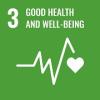SDG03 in the classroom: Good Health and Well-being.
“Ensure healthy lives and promote well being for all at all ages”
At the end of this lesson, students will be able to
1. Distinguish between the concepts of health and well-being
2. Understand the difference between communicable and noncommunicable diseases
3. Understand some causes of maternal mortality
4. Understand the importance of the achievement of SDG3
5. Gain some insights about substance use disorders and some treatments 6. Analyze one chosen digital story on SDG3 by answering the questions
Brainstorming session through the following questions.
- What is health? 1 What is well-being? 2
- What are good practices/habits to stay healthy? For instance, having a balanced diet is necessary. What else?
- Diseases are divided into communicable (ie tuberculosis) and noncommunicable diseases (ie cancer) 3 . Do you know the difference between the two? Can you make other examples?
- Do you think most of the deaths occurring are preventable or not?
- Maternal mortality (the death of a woman during pregnancy, childbirth, or the puerperium) is a very urgent issue to solve together with neonatal death (when a baby dies in the first 28 days of life). What are the causes of maternal mortality? How could it be prevented?
- Can everyone have equal access to healthcare facilities? Why?
- Substance use disorders (also known as drug addictions like addiction to tobacco, alcohol, and other illicit drugs) are in the target for SDG3. Do you know any treatment or prevention programs for substance use disorders?
- According to the Dutch philosopher, Desiderius Erasmus (1500), “prevention is better than cure”. Do you agree or disagree?
1 Note for teachers: Definition of health (WHO).
2 Note for teachers: Definition of well-being.
3 Note teachers: Definition of communicable diseases and Noncommunicable diseases.
Possible adaptations: (Online) This activity can be done with the use of online tools (i.e. Jamboard; Miro, Mentimeter).
Take a shoebox or any other box. Ask students to individually answer the following questions on a paper: Is good mental health as important as physical health? Why/Why not?
Keeping the answers anonymous allows students to talk more openly about private matters in a safe way. Then, ask them to put it in the box and shuffle it. Pick each paper from the box and read it aloud. For each paper, note down the main keywords on a blackboard (i.e. balance).
Afterwards, watch “ We all have mental health ” a video that explains the importance of speaking out and asking for help when we don't feel well (mentally).
Then, following the same procedure as before, ask students to answer anonymously the following questions:
- Do you feel mentally unwell sometimes (for instance, very sad at times or anxious under a particular circumstance)?
- What would you do if you didn't feel mentally well?
Then, ask them to put it in the box and shuffle it. Pick each paper from the box and read it aloud.
Possible adaptation: You can also ask each student to pick a paper and read it aloud while you note down the keywords on a blackboard.
Good health and well-being is the 3rd SDG established by the United Nations.

Play these three videos in sequence. Afterward, ask students to pick one video and explain:
- How it is related to SDG3 (what targets is it addressing?)
- The overall message the author wants to convey.
- The lessons you learned
1. Preventing Cardiovascular Diseases, SPICES DST PROJECT (South Africa)
2. The fight against Malaria in Tambacounda (Senegal)
3. Need for a midwife in the community (DRC)
Possible adaptations: It is suggested to do this activity individually. Otherwise, use the gallery walk methodology (see example here): attach three pictures of the videos on the wall and ask students to write comments (related to the 3 main questions) around each. Finally, all the comments for each picture can be read together and discussed with the whole group.
This quiz is about UN Goal 3: Good Health and Well-being. You can either use it at the end of your lesson to revise the topics you have already talked about, or in the beggining of the lesson to challenge students prior knowledge and gain their attention.
For SDG 3 (good health and well-being) sheet, our favorite pedagogical twist is:
For the development of a specific activity, invite an expert in the field. In this case, a doctor for the brainstorming session or a psychologist/school psychologist for activity 2. Gaining insights or feedback from an expert in the field can trigger deeper engagement and foster motivation among students.
If you have another pedagogical twist in mind, feel free to apply or check the pedagogical twist list.

A gift for Comundos
Over the years, Comundos has helped remote communities around the world by teaching critical thinking, media literacy and the use of communication technology.
To do this effectively, we need your support for computers, translations, courses and social media management.
Thank you .
BE11 1030 2973 8248




